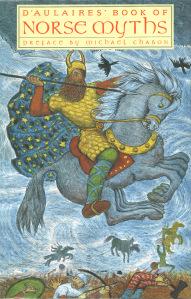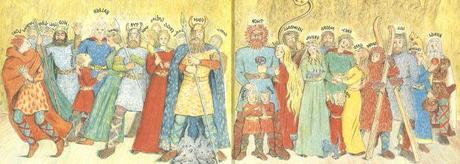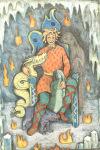 Early in the morning of time there was no sand, no grass, no lapping wave. There was no earth, no sun, no moon, no stars. There was Niflheim, a waste of frozen fog, and Muspelheim, a place of raging flame. And in between the fog and fire was a gaping pit–Ginungagap.
Early in the morning of time there was no sand, no grass, no lapping wave. There was no earth, no sun, no moon, no stars. There was Niflheim, a waste of frozen fog, and Muspelheim, a place of raging flame. And in between the fog and fire was a gaping pit–Ginungagap.
Thus begins the creation myth in the D’Aularies’ Book of Norse Mythology. The husband and wife team, Ingri & Edgar Parin d’Aulaire, followed up their successful D’Aulaires’ Book of Greek Mythology, pubilshed in 1961, with this volume of mythology from the Northern climes in 1967. This picture book is an excellent and accessible presentation of thirty Norse myths. As with their previous volume, each myth is narrated in storybook fashion along with memorable illustrations.
Norse mythology is largely based upon the Eddas, two volumes in Old Norse that date back to the early 13th century in Iceland. Snorri Sturluson is credited with the creation of the Prose Edda. Around the same time, earlier oral traditions were complied and written down to become the Poetic Edda. The Eddas, in particular the Poetic Edda, are the primary source for much of our present day knowledge of Norse mythology and some Teutonic or Germanic myths, involving such heroes as Siegfried (or Sigurd).

The pantheon of Norse gods. Key figures include: Odin, father of the gods; Thor, the thunder god; Frigg, Odin’s wife; Frey and Freya; Balder, god of beauty; Heimdall, the watchman; and Loki, the trickster god of fire.
Perhaps the most well-known characters are Thor and Loki. The profile of these two juxtaposed characters has increased in recent years due to the release of feature films produced by Marvel Comics. Thor, Loki, and other figures from Norse mythology have been staples of Marvel since 1962. However, in Norse myth, unlike Marvel lore, Thor and Loki are not related. Loki is foster brother to Odin, Thor’s father, and not his son.
Many of the featured stories revolve around Thor’s heroics and Loki’s cunning. Some of these adventures read much like the Labors of Hercules of Greek myth. In fact several elements of the Norse myths eerily recall familiar circumstances in the Greek ones. There are the Norn who spin the threads of fate much like the Greek Moirae. The goddess Idunn, who cultivates the apples which keep the gods youthful, may remind one of Hebe, the Greek goddess of youth; and like ambrosia, food of the Greek gods, the apples recall the golden apples of the Hesperides. Just to name a few.

Loki and his children: the Midgard Serpent, the wolf Fenris and Hel.
Unlike Greek mythology, however, the myths of the Norse reflect a more unforgiving, harsher clime. Dark and icy landscapes are familiar settings and the twilight of the gods, Ragnarök, is a brutal ending to the gods and their ilk. “The earth split open, all the way to the world of the dead, and all the bonds of the world broke with a twang.” “Out of the north came a goulish ship, the Nagelfar. Its sides were covered with clippings of finger- and toenails, and it was manned by a crew of ghosts. Standing at the rudder and sailing the ship straight through the raging sea was Loki, coming back for revenge.”
Here, gods are not immortal. Balder, god of beauty, is just the first to succumb to death, killed by Hod, the blind god of winter. After Ragnarök, however, Balder appears to be reborn, much like the return of the sun after the endless days of night witnessed in the far north.
The Norse myths are perhaps best reserved for older children who have first read and experienced the Greek myths, but this volume may appeal to children of all ages. With tales of giants, trolls, and dark elves, these stories—with gods and heroes traversing the nine realms—are a must for fans of fantasy. These myths inspired J. R. R. Tolkien’s Middle-earth, which derives from Midgard, the Norse world of men.
The cover pictured above is from the 2005 re-issue edition. The book was originally published under the title, Norse Gods and Giants.

